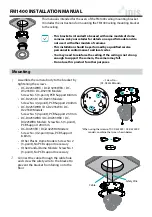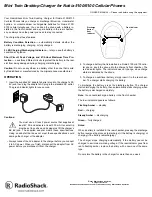
38
TRUE FOCUS AND CAMERA HANDLING
To obtain the maximum benefit from True Focus you should
try to work within the requirements of the system. This
might need a little practice but it will improve the accuracy
of the measurements and thereby provide better results.
Firstly, try to remain as still as possible when making the first
True Focus measurement and wait for the audio signal or
ready light to show green again before continuing. This will
not only speed up the process but also increase accuracy.
Secondly, when recomposing the shot you should try to
stay in the same position as closely as possible. That is, try to
avoid moving your head or body forwards or backwards as
this will move the camera away from the measured position.
In the upper example to the right, the photographer has
swung the camera from the first measurement to recom-
pose the shot as normal. But you can see that the camera
has now moved away from the original position.
The lower example illustrates essentially the same situation
except this time the camera is more or less rotated around
its central axis, rather than swung. The difference might
seem slight but practice has shown that this method does
retain the original position more accurately and therefore
results in better focusing accuracy.
A very effective way of checking the
focus of individual captures is to as-
sign the P1 or P2 (or Mirror Up or Stop
Down) button to Focus Confirm.
In browse mode or after capture,
press the P button. A cursor appears
on the display which can be navi-
gated via the scroll wheels or Naviga-
tion button to pinpoint the required
area. Another press of the P button
will zoom onto that particular part of
the image for focus confirmation. The
control wheels (or the Navigator) can
now be used if areas close by are to
be also checked. Otherwise, press it
again to return to cursor view to be
able to make a rapid new placement
of the cursor for more checking.
In True Focus mode, instead of being
located in the centre of the display,
the cursor is automatically located
near the original area chosen by you
for the True Focus setting. This meth-
od provides a very convenient and
rapid method for checking when us-
ing True Focus.
✘
✔
FOCUS CHECKING IN BROWSE, PREVIEW OR TRUE FOCUS MODE
In True Focus, make a True Focus set-
ting focused on the model’s ear, for ex-
ample. After recomposition, press the
assigned P button which automatically
positions the cursor over the chosen
area. One more press of the P button
produces a zoomed in close-up of the
chosen area for focus checking without
the need for extra navigation.
While browsing, press the assigned P button to activate the cursor which appears in the
middle of the frame. Use the front and rear scroll wheels to move the cursor to the eye, for
example. Press the P button again to produce a zoomed in close-up of the chosen area for
focus checking.
Correct ‘rotation’ of camera.
Incorrect ‘swinging’ of camera away from
original position.
Summary of Contents for H5D
Page 1: ...1 USER MANUAL v11 ...
Page 2: ...2 INTRODUCTION ...
Page 19: ...19 Photo Dmitry Ageev Hasselblad Masters GENERAL ...
Page 31: ...31 Photo Roman Jehanno Hasselblad Masters LENSES FOCUS MODES ...
Page 42: ...42 Photo Martin Schubert Hasselblad Masters EXPOSURE CONTROL ...
Page 48: ...48 Photo Hengki Koentjoro Hasselblad Masters NAVIGATING THE MENUS ...
Page 52: ...52 Photo Dmitry Ageev Hasselblad Masters PREVIEWS BROWSING ...
Page 56: ...56 SENSOR UNIT SETTINGS Photo Hengki Koentjoro Hasselblad Masters ...
Page 71: ...71 Photo Bara Prasilova Hasselblad Masters GRIP MENU SETTINGS ...
Page 87: ...87 PROFILES Photo Rafal Maleszyk Hasselblad Masters ...
Page 90: ...90 Photo Bara Prasilova Hasselblad Masters FLASH STROBE ...
Page 94: ...94 HM 16 32 FILM MAGAZINE OPTIONAL ACCESSORY Photo Hengki Koentjoro Hasselblad Masters ...
Page 102: ...102 ACCESSORIES Photo Roman Jehanno Hasselblad Masters ...
Page 108: ...108 APPENDIX Photo Bryn Griffiths Hasselblad Masters ...
Page 118: ...118 H5D UM 1L v11 2015 Copyright 2015 Victor Hasselblad AB ...
















































